Related Research Articles

Pentecostalism or classical Pentecostalism is a Protestant Charismatic Christian movement that emphasizes direct personal experience of God through baptism with the Holy Spirit. The term Pentecostal is derived from Pentecost, an event that commemorates the descent of the Holy Spirit upon the followers of Jesus Christ, and the speaking in "foreign" tongues as described in the second chapter of the Acts of the Apostles. In Greek, it is the name for the Jewish Feast of Weeks.

Calvary Baptist Church is a Baptist independent church, located at 123 West 57th Street between the Avenue of the Americas and Seventh Avenue, near Carnegie Hall in Midtown Manhattan, New York City. The 123 W. 57th Street facility is under renovation - until the renovation is complete, Calvary will gather every Sunday at 10 a.m. at Assembly Hall on the Manhattan campus of Hunter College, located at 695 Park Ave, New York, NY 10065, North Building, E. 68th St. The church also gathers online every Sunday morning at live.cbcnyc.org.
The Azusa Street Revival was a historic series of revival meetings that took place in Los Angeles, California. It was led by William J. Seymour, an African-American preacher. The revival began on April 9, 1906, and continued until roughly 1915. On the night of April 9, 1906, Seymour and seven men were waiting on God on Bonnie Brae Street, "when suddenly, as though hit by a bolt of lightning, they were knocked from their chairs to the floor," and the other seven men began to speak in tongues and shout out loud praising God. The news quickly spread; the city was stirred; crowds gathered; and a few days later Seymour himself received the Holy Spirit; services were moved outside to accommodate the crowds who came from all around; people fell down under the power of God as they approached; people were baptized in the Holy Spirit and the sick were healed and sinners received salvation. The testimony of those who attended the Azusa Street Revival was "I am saved, sanctified, and filled with the Holy Ghost" in reference to the three works of grace of Holiness Pentecostals, the original branch of Pentecostalism. To further accommodate the crowds, an old dilapidated, two-story frame building at 312 Azusa Street in the industrial section of the city was secured. This building, originally built for an African Methodist Episcopal (AME) church, had more recently been used as a livery stable, storage building and tenement house. In this humble Azusa Street mission, a continuous three-year revival occurred and became known around the world. Stanley H. Frodsham, in his book, With Signs Following, quotes an eye-witness description of the scene: The revival was characterized by spiritual experiences accompanied with testimonies of physical healing miracles, worship services, and speaking in tongues. The participants were criticized by some secular media and Christian theologians for behaviors considered to be outrageous and unorthodox, especially at the time. Today, the revival is considered by historians to be the primary catalyst for the spread of Pentecostalism in the 20th century.

Carmarthen is the county town of Carmarthenshire and a community in Wales, lying on the River Towy. 8 miles (13 km) north of its estuary in Carmarthen Bay. The population was 14,185 in 2011, down from 15,854 in 2001, but gauged at 16,285 in 2019. It has a claim to be the oldest town in Wales – Old Carmarthen and New Carmarthen became one borough in 1546. It was the most populous borough in Wales in the 16th–18th centuries, described by William Camden as "chief citie of the country". Growth stagnated by the mid-19th century as new settlements developed in the South Wales Coalfield.

The Elim Pentecostal Church is a UK-based Pentecostal Christian denomination.

Times Square Church is an interdenominational congregation located at the Mark Hellinger Theatre on 237 West 51st Street in the Theater District of Manhattan in New York City. Times Square Church was founded by Pastor David Wilkerson in 1987 and bought the Mark Hellinger Theatre in 1991.
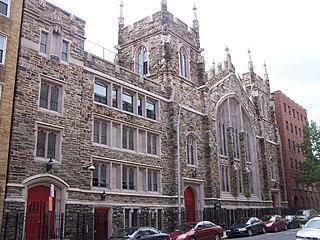
The Abyssinian Baptist Church is a Baptist megachurch located at 132 West 138th Street between Adam Clayton Powell Jr. Boulevard and Lenox Avenue in the Harlem neighborhood of Manhattan, New York City, affiliated with the National Baptist Convention, USA.

Holy Corner is a colloquial name for a small area of Edinburgh, Scotland, and is part of the area more properly known as Burghmuirhead, itself part of the lands of Greenhill. Holy Corner lies between the areas of Bruntsfield and Morningside.
George Jeffreys was a Welsh evangelist who founded the Elim Pentecostal Church, a Pentecostal organisation.
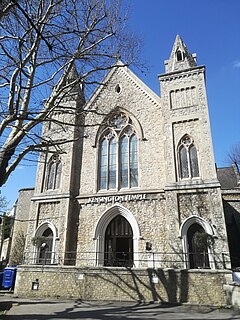
Kensington Temple is a Pentecostal Church in the Notting Hill area of London, England. It is pastored by Reverend Mark Ryan, and is the largest church in its denomination, the Elim Pentecostal Church.
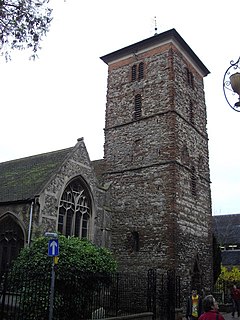
Colchester in Essex, England, has a number of notable churches.

Elim Bible Institute and College is a Christian Bible college in Lima, New York, United States. The school awards an associate degree as well as certificates.

Fifth Avenue Presbyterian Church is a Presbyterian Church (U.S.A.) church in New York City. The church, on Fifth Avenue at 7 West 55th Street in Midtown Manhattan, has approximately 2,200 members and is one of the larger PCUSA congregations. The church, founded in 1808 as the Cedar Street Presbyterian Church, has been at this site since 1875.
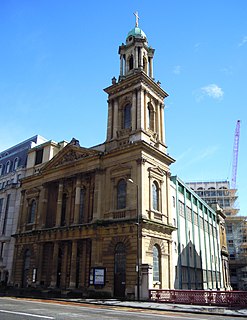
The City Temple is a Nonconformist church on Holborn Viaduct in London. The current minister is Rodney Woods. The church is part of the Thames North Synod of the United Reformed Church and is a member of the Evangelical Alliance.
Wightman Memorial Baptist Church in Oyster Bay, New York, was first built in 1908. It is the third building on this site. The first Baptist congregation met in Oyster Bay as early as 1700, and Oyster Bay received its first ordained minister in 1724. The second church building, constructed in 1806 is still visible on the site, behind the newer structure.

St Augustine's Church is a former Anglican church in Brighton, part of the English city of Brighton and Hove. It is close to the Preston Park and Round Hill areas in the central northern part of the city. Built in 1896 and extended in 1914, its parish was extended after a nearby church closed, but in 2003 it was declared redundant itself. The building, which is listed at Grade II in view of its architectural importance, for a few years from 2004 the building was leased by the Elim Pentecostal Church. The Pentecostal congregation made free-standing internal changes to create internal spaces which could be heated in winter, but did not touch the fabric of the building. It is now the St Augustine's Community Arts Centre, encompassing a cafe, exhibition space, offices, and other rooms.

The Union Chapel, also known as the Union Street Chapel, Elim Free Church, Four Square Gospel Tabernacle or Elim Tabernacle of the Four Square Gospel, is a former chapel in the centre of Brighton, a constituent part of the city of Brighton and Hove, England. After three centuries of religious use by various congregations, the chapel—which had been Brighton's first Nonconformist place of worship—passed into secular use in 1988 when it was converted into a pub. It was redesigned in 1825, at the height of Brighton's Georgian building boom, by at least one of the members of the Wilds–Busby architectural partnership, Brighton's pre-eminent designers and builders of the era, but may retain some 17th-century parts. It has been listed at Grade II in view of its architectural importance.
West Presbyterian Church was a congregation and two houses of worship in Manhattan, New York City. The congregation was founded in 1829 and merged in 1911 with Park Presbyterian Church to form West-Park Presbyterian Church. The first house of worship, also known as the Carmine Street Presbyterian Church, in Greenwich Village, was used from 1832 to 1865, and the second, on West 42nd Street between Fifth Avenue and Sixth Avenue, from 1865 until 1911, when it was sold and demolished. Proceeds from the sale were used, in accordance with the merger agreement, to build and endow a church for an underserved neighborhood, Washington Heights: Fort Washington Presbyterian Church. In addition, the West Church congregation had earlier established two mission churches which eventually merged to become Good Shepherd-Faith Presbyterian Church. West-Park, Fort Washington, and Good Shepherd-Faith are all active today.
Glad Tidings Tabernacle is a church located at 2207 Adam Clayton Powell Jr. Boulevard between West 130th and 131st Street in the Harlem neighborhood of Manhattan, New York City. It has served New York City since 1907 with a focus on different cultures and diversity.
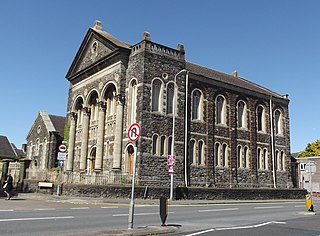
Tabernacle Chapel is an Independent (Congregational) chapel in the town of Llanelli, Carmarthenshire, Wales. It was built in 1872 and is located at 17 Cowell Street. It is a Grade II* listed building.
References
- 1 2 Don, Hunt. "History of Elim Llanelli". beehive.thisissouthwales.co.uk. Retrieved 2009-06-12.
- ↑ Bill and Ellen Chapman. "Spotlight Elim". www.revivaltimes.org. Retrieved 2009-06-12.